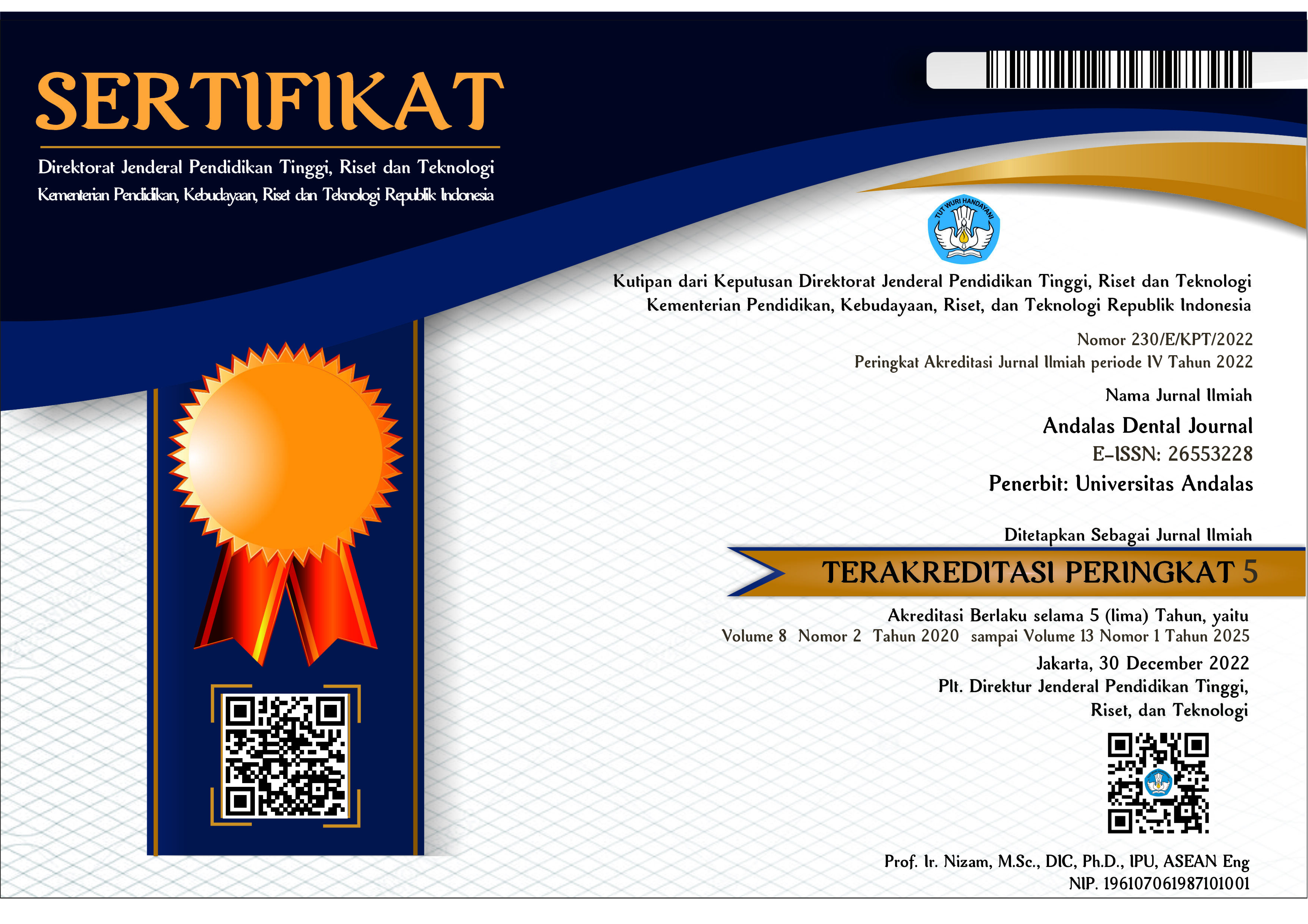THE EFFECT OF MIXING SODIUM HYPOCHLORITE ON COMPRESSIVE STRENGTH OF TYPE III GYPSUM PRODUCT
Abstract
Disinfection is needed to avoid transmission of infectious agents. One of disinfectant solution used is sodium hypochlorite. Disinfection should be done without changing the quality of gypsum models, so the technique of mixing a disinfectant solution on gypsum powder can be used as an alternative. The purpose of this study was to determined the effect of mixing sodium hypochlorite to the compressive strength of type III gypsum product. The study was conducted at the Laboratory of Materials and Structures, Faculty of Engineering, Andalas University using laboratory experimental method with 30 pieces of type III gypsum models as samples. Samples were divided into 5 groups, that were mixed using 0.5% sodium hypochlorite, 1% sodium hypochlorite, 2% sodium hypochlorite, 5% sodium hypochlorite and distilled water as a control group. Measurement of the compressive strength was performed with a Universal Testing Machine (UTM). The results showed that the models were mixed with 0.5% sodium hypochlorite, 1% sodium hypochlorite, 2% sodium hypochlorite and 5% sodium hypochlorite reduced the average of the compressive strength compared to the models that are mixed with distilled water. One Way ANOVA test showed that was significantly differences (p<0.05) among groups of 0.5% sodium hypochlorite, 1% sodium hypochlorite, 2% sodium hypochlorite, 5% sodium hypochlorite and distilled water as a control group. It was concluded that there were effect of mixing sodium hypochlorite to reduced the compressive strength of type III gypsum product.
Keywords: type III gypsum, compressive strength, sodium hypochlorite
References
2. Hatrick CD, Eakle WS, Bird WF (2003). Dental Materials: Clinical Applications for Dental Assistants and Dental Hygienists. USA: Saunders Elsevier Inc. H 230-248
3. Power JM, Wataha JC (2008). Dental Materials: Properties and Manipulation. 9th ed. St. Louis: Elsevier Inc.
4. Sakaguchi RL, Power JM (2012). Craig’s Restorative Dental Materials. 13th ed. Philadelphia : Elsevier Inc. H 300-309.
5. Zarakani H, Karimi N, Sadriya S, Fayaz A., 2013. Comparison of Setting Time, Setting Expansion and Compressive Strength of Gypsum Casts Produced by Mixing Gypsum Powder with Distilled Water or 0,5% Sodium Hypochlorite. Journal of Dental School. H 162-169
6. Anaraki, M.R., Moslehifard, E., Aminifar, S. and Ghanati, H., 2013. Effect of Microwave Disinfection on Compressive and Tensile Strengths of Dental Stones. Journal of Dental Research, Dental Clinics, Dental Prospects, 7(1), H 42.
7. Moslehifard, E., Nasirpouri, F. and Gasemzadeh, S., 2013. Effect of Disinfectants on the Hardness of Dental Stones. Journal of Islamic Dental Association of IRAN (JIDAI), 25(2), H 2.
8. Mahboobi, N., Agha‐Hosseini, F., Safari, S., Lavanchy, D. and Alavian, S.M., 2010. Hepatitis B Virus Infection in Dentistry: A Forgotten Topic. Journal of viral hepatitis, 17(5), H 307-316.
9. Marya, C.M., Shukla, P., Dahiya, V. and Jnaneswar, A., 2011. Current Status of Disinfection of Dental Impressions in Indian Dental Colleges: A Cause of Concern. The Journal of Infection in Developing Countries, 5(11), H 776-780.
10. Al-khafaji, A.M., Abass, S.M. and Khalaf, B.S., 2013. The Effect of SOLO and Sodium Hypochlorite Disinfectant on Some Properties of Different Types of Dental Stone. Journal of Baghdad College of Dentistry, 25(2), H 8-17.
11. Lucas, M.G., Arioli‐Filho, J.N., Nogueira, S.S., Batista, A.U.D. and Pereira, R.D.P., 2009. Effect of Incorporation of Disinfectant Solutions on Setting Time, Linear Dimensional Stability, and Detail Reproduction in Dental Stone Casts. Journal of Prosthodontics, 18(6), H 521-526.
12. Khalaf, H.A.R. and Mohammed, M.R., 2014. Effect of Disinfectant Agents on Certain Physical and Mechanical Properties of Type IV Dental Stone. Journal of Baghdad College of Dentistry, 26(1), H 24-31.
13. Sabouhi, M., Khodaeian, N., Ataei, E. and Kiani, F., 2014. The effect of addition of calcium hypochlorite disinfectant on setting expansion and surface hardness of dental stone. Journal of Islamic Dental Association of Iran, 26(1), H 29-34.
14. Mohan, T.K., Sandeep, C., Gopinadh, A., Manne, P. and Dev, J.R.R., 2012. An Evaluation Of The Effect Of Mixing Disinfectant Solutions On Physical Properties Of Die Stone Material-An In Vitro Study. Indian Journal of Dental Sciences, 4(5).
15. Memarian, M., Fazeli, M.R., Jamalifar, H., Azimnejad, A., 2007. Disinfection Efficiency of Irreversible Hydrocolloid Impressions Using Different Concentrations of Sodium Hypochlorite: A Pilot Study. The Journal of Contemporary Dental Practice, 8(4)
16. Doddamani, S., Patil, R.A., Gangadhar, S.A,. 2011. Efficacy of various spray disinfectants on irreversible hydrocolloid impression materials: An in vitro study. Indian Journal of Dental Research, 22(6), H 764-769.
17. Hasan, R.H. and Mohammad, K.A., 2013. The Effects of Drying Techniques on The Compressive Strength of Gypsum Products. Al-Rafidain Dental Journal, 5(1).
18. National Ready Mixed Concrete Association (2003). CIP 35 – Testing Compressive Strength on Concrete
19. Abdelaziz K.M., Combe E.C., Hodges J.S.,2002. The Effect of Disinfectant Additives on The Properties of Dental Gypsum: 1. Mechanical Properties. Journal of Prosthodontics, 11(3), H 161-167.
20. Mohammad, Q.A., Hasan, R.H. and Thiab, S.S., 2014. Effects of Different Disinfectant Additives on Compressive Strength of Dental Stone. Journal of Babylon University, 22















